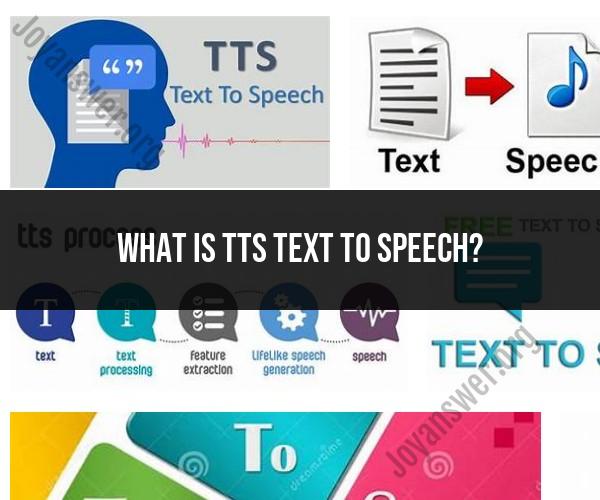What is TTS text to speech?
TTS, or Text-to-Speech, is a technology that converts written text into spoken language. It is a form of speech synthesis that enables computers, devices, and applications to audibly communicate text content to users. TTS technology uses algorithms and digital recordings of human voices to generate spoken words and sentences from written text.
Key components and features of TTS technology include:
Text Input: Users input written text, such as a document, webpage, or user-generated content, into a TTS system.
Text Analysis: TTS systems analyze the input text to identify words, sentences, punctuation, and other linguistic elements.
Voice Synthesis: TTS technology uses digital recordings of human voices or synthetic speech models to create audible speech from the analyzed text. Depending on the system, different voices and accents may be available.
Natural Language Processing (NLP): Some advanced TTS systems incorporate NLP techniques to enhance the naturalness and fluency of synthesized speech. This includes the interpretation of context, intonation, and prosody (the rhythm and pattern of speech).
Voice Customization: Some TTS systems allow users to choose from a variety of voices and adjust settings such as pitch, speed, and tone to customize the spoken output.
Multilingual Support: TTS technology supports multiple languages, enabling users to convert text into speech in different languages and dialects.
TTS technology has a wide range of applications, including:
Accessibility: TTS is a crucial tool for individuals with visual impairments or reading difficulties. Screen readers and assistive technology devices use TTS to read aloud text content from computers, smartphones, and other digital devices.
Navigation and Virtual Assistants: GPS navigation systems and virtual assistant applications use TTS to provide spoken directions, information, and responses to user queries.
E-Learning: TTS is used in e-learning platforms to read course materials and instructions aloud to learners, making content more accessible.
Customer Service: Interactive voice response (IVR) systems and chatbots employ TTS to deliver automated customer service responses over the phone or through messaging platforms.
Content Consumption: Audiobooks, podcasts, and news articles can be converted into spoken form using TTS, making it easier for people to consume content while on the go.
Language Learning: Language learning applications use TTS to teach pronunciation and accent by providing native speaker-like pronunciation of words and phrases.
Accessibility in Public Spaces: Public transportation systems and public spaces often use TTS to announce information such as train schedules, bus stops, and elevator status to assist passengers.
TTS technology continues to advance, with improvements in voice quality, naturalness, and multilingual capabilities. It plays a vital role in making digital content more accessible and enhancing the user experience in various applications and services.
What is Text-to-Speech (TTS)?
Text-to-speech (TTS) is a technology that converts text into spoken words. It is also known as speech synthesis. TTS systems use a variety of techniques to generate synthetic voices that sound as natural as possible.
How TTS Systems Work to Generate Speech from Text
TTS systems typically work in the following steps:
- Text analysis: The system first analyzes the text to identify the individual words, phrases, and sentences.
- Phoneme analysis: The system then breaks down each word into its individual phonemes, which are the smallest units of sound in a language.
- Prosody analysis: The system also analyzes the text's prosody, which includes factors such as pitch, intonation, and rhythm.
- Speech synthesis: The system then synthesizes the phonemes and prosody to generate the spoken output.
Uses and Capabilities of Text-to-Speech Technology
TTS technology is used in a wide variety of applications, including:
- Accessibility: TTS can be used by people who are blind or have other visual impairments to access written content.
- Education: TTS can be used to help students learn to read and write. It can also be used to create educational materials that are accessible to a wider range of students.
- Entertainment: TTS is used to create audiobooks, podcasts, and other audio content. It is also used to create voiceovers for videos and animations.
- Customer service: TTS is used to create chatbots and other customer service applications that can communicate with customers in a natural way.
- Productivity: TTS can be used to create dictation software and other productivity tools.
TTS technology is constantly evolving, and new applications are being developed all the time. For example, TTS is now being used to create virtual assistants and other AI-powered applications.
Here are some of the capabilities of modern TTS systems:
- Natural-sounding voices: TTS systems can now generate synthetic voices that sound very natural, even to native speakers.
- Multilingual support: TTS systems can generate speech in a variety of languages, making them accessible to a global audience.
- Customizable voices: TTS systems can be customized to create unique voices with different accents, timbres, and speaking styles.
- Emojis and other non-verbal cues: TTS systems can now interpret and generate emojis and other non-verbal cues, making the spoken output more expressive and engaging.
TTS technology is a powerful tool that can be used to improve communication and accessibility in a variety of settings. As TTS technology continues to improve, we can expect to see it used in even more applications in the future.













